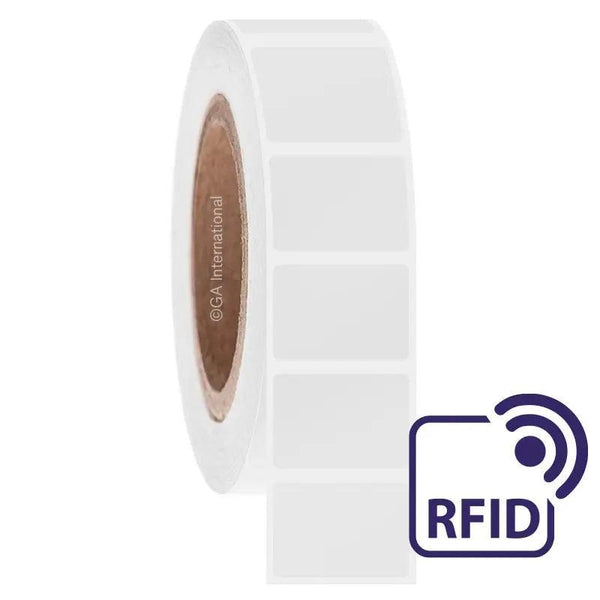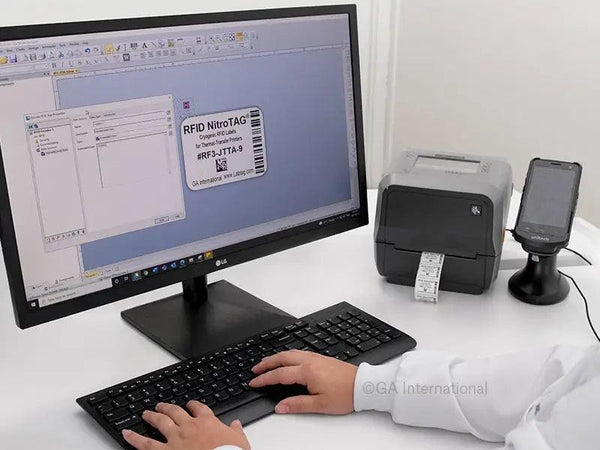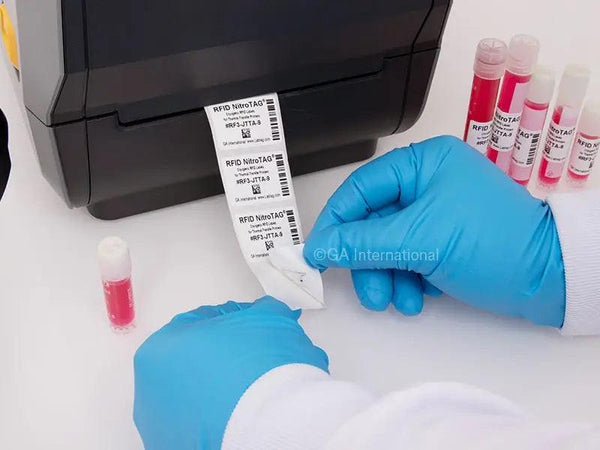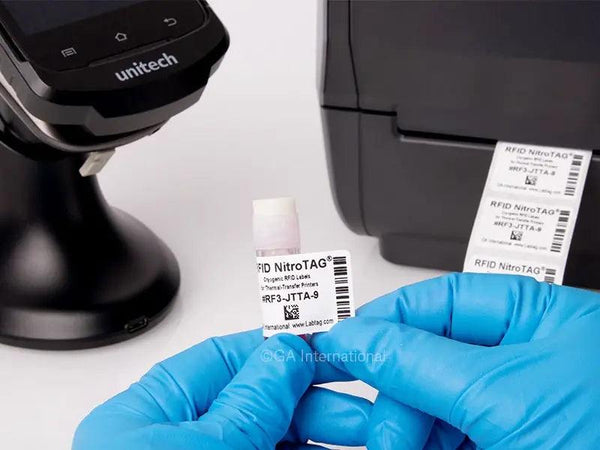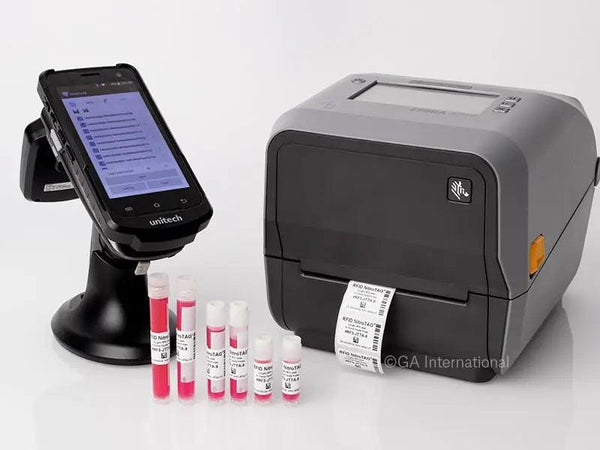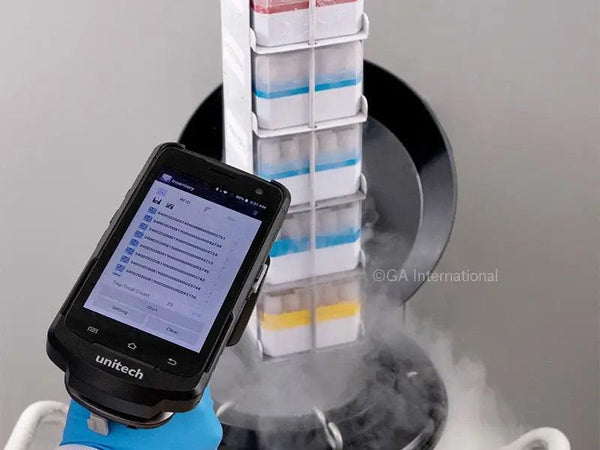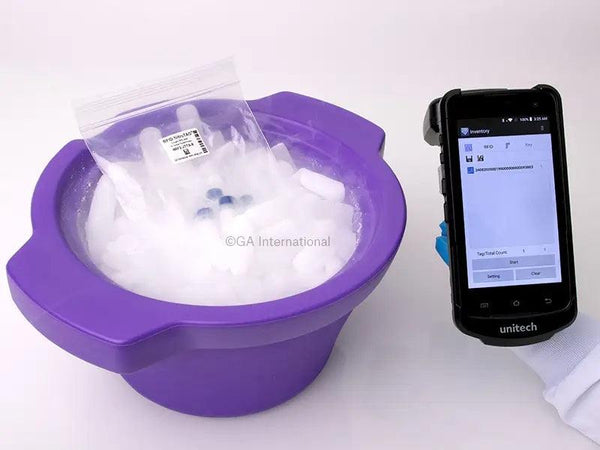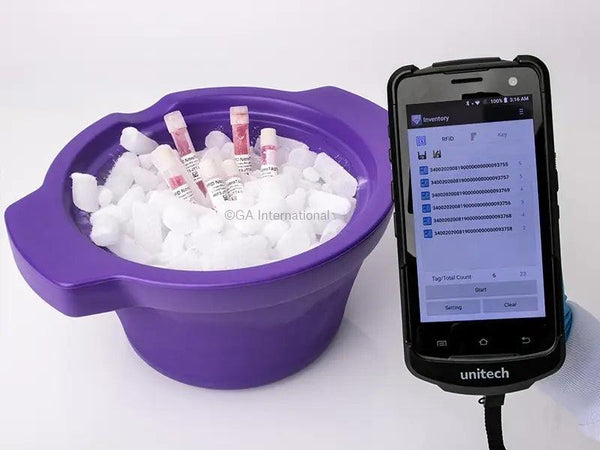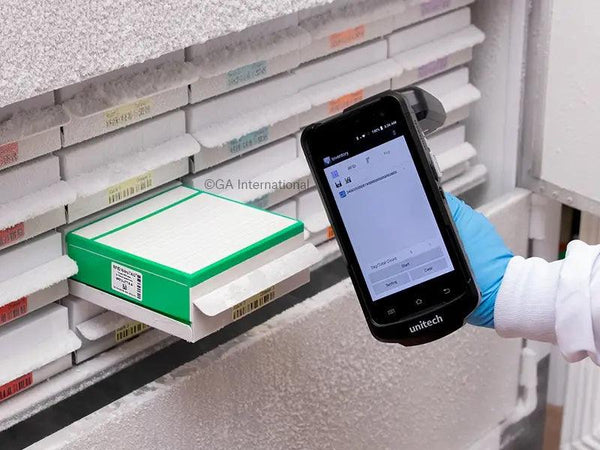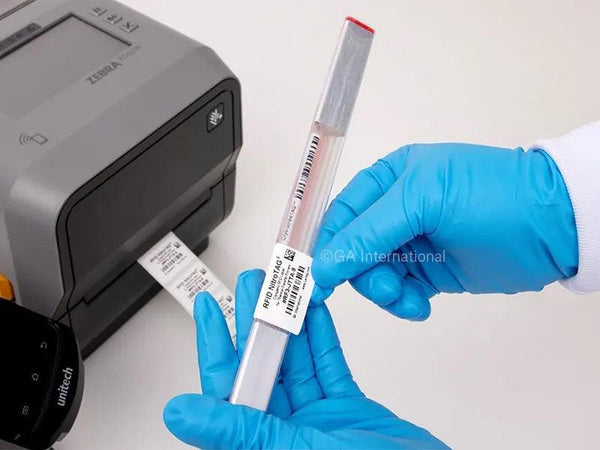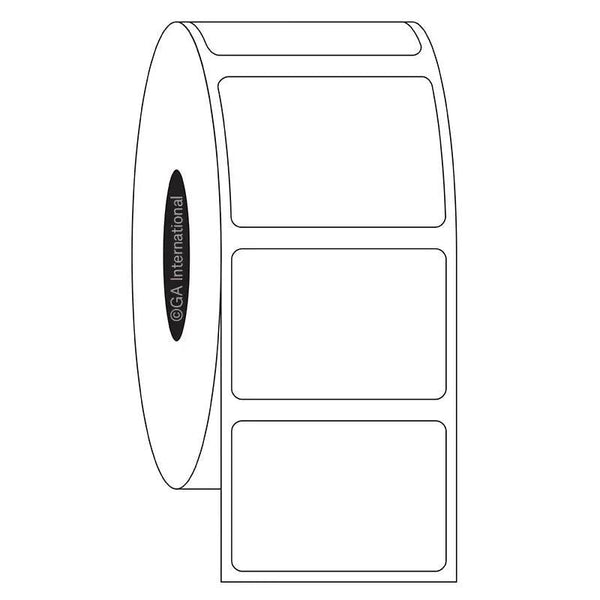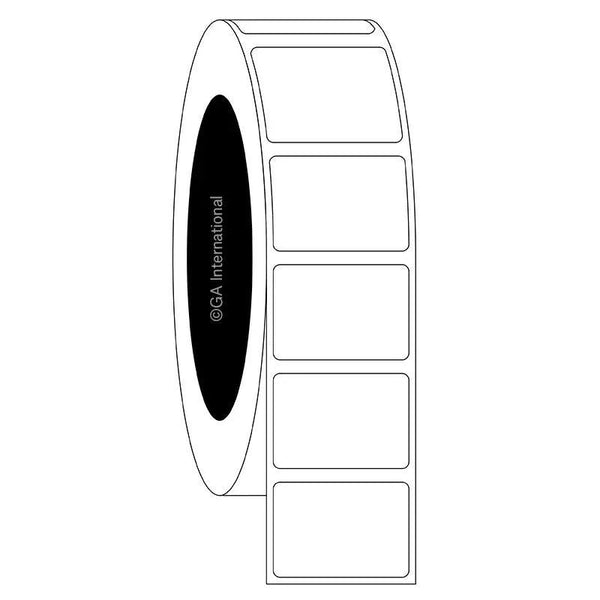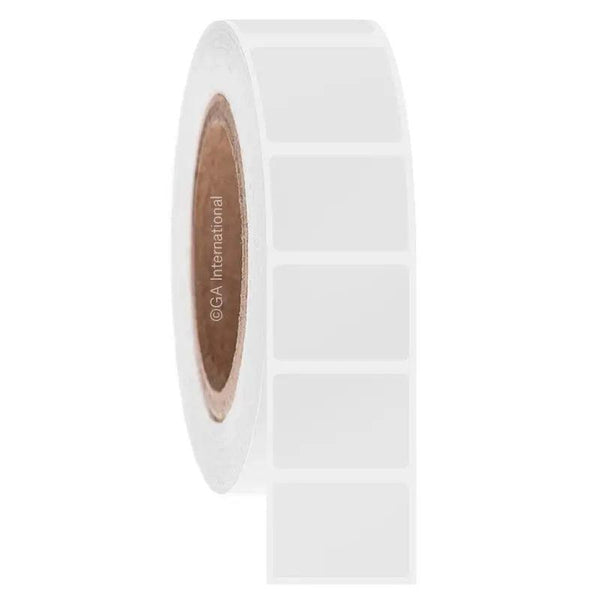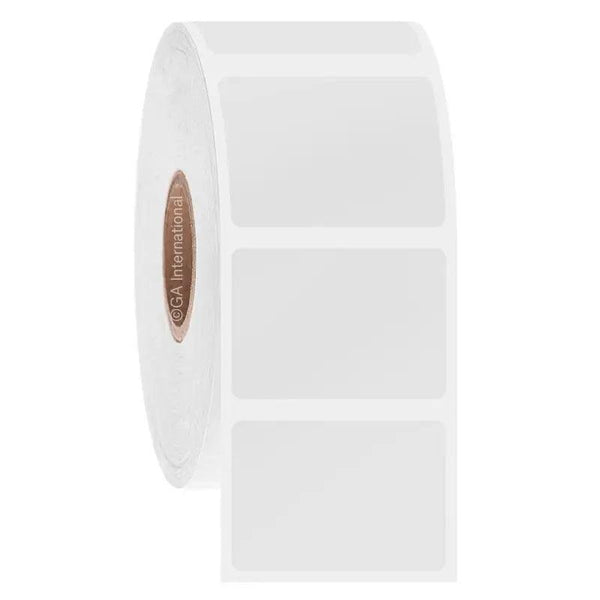
Cryogenic RFID Labels for Thermal-Transfer Printers – 1.25″ x 0.875″
Cryogenic RFID Labels for Thermal-Transfer Printers – 1.25″ x 0.875″
RFID NitroTAG® – Cryogenic RFID Labels for Thermal-Transfer Printers
Size: 1.25″ x 0.875″ / 31.8mm x 22.2mm
Label across: 1
Color: White
Labels/roll: 1,000
Core size: 1″ or 3″ / 25.4mm or 76.2mm
Perforation: No
Adhesive: Max strength extra-permanent
Temperature range: -196°C to +110°C (-321°F to +230°F)
Operating temperature/RFID functional temperature range: -35°C to +85°C / -31°F to +185°F
Recommended Ribbons: RR-Class Smudge and Alcohol Proof Resin Ribbons
Combining RFID technology and our thermal-transfer printable cryogenic labels into one product, RFID NitroTAG® labels are the first cryogenic RFID labels that can be used in liquid nitrogen. They can be printed and encoded using dedicated RFID thermal-transfer printers. Their flexible, passive UHF RFID chip (Class 1, Gen 2) can be encoded with up to 32 hexadecimal characters of information to record data during sample processing. The resulting label can thus contain both visual and electronic data for maximum sample tracking flexibility.
RFID NitroTAG labels are specifically designed for short and long-term storage under ultra-low temperatures and cryogenic environments, including liquid and vapor phase liquid nitrogen (-196ºC/-321°F), lab freezers (-80°C/-112°F), and dry ice transportation. They have a strong permanent adhesive to ensure they will stay affixed on cryo tubes & vials*, cardboard and polypropylene cryo/freezer boxes, plastic bags, and triangular cassettes for straw storage. They can be scanned/read without the need for direct line-of-sight, even when in liquid nitrogen** or immersed up to 1.5”/38mm*** in a 37°C water bath. This can help eliminate unwanted freeze-thaw cycles, thus preserving the samples’ integrity. They are ideal for biobanks, biorepositories, fertility clinics, and crystallography laboratories.
These RFID labels are compatible with handheld, fixed, integrated, and cryogenic (Dewar neck) RFID readers. Moreover, they can be integrated with electronic witnessing systems to improve the identification and traceability of samples, as well as workflow efficiency to comply with audits. The printout obtained is also resistant to alcohol spraying/swabbing and sanitizing wipes when printed with our recommended smudge-proof RR-class of resin ribbons.
RFID NitroTAG label size can be customized upon request.
Benefits:
- 12” omnidirectional read range***ensures quick, easy, and accurate reading from every angle
- Scan multiple cryogenic containers at the same time, even without a clear line-of-sight**
- Flexible UHF antenna and cryogenic adhesive allow permanent adhesion, especially on curved and wet surfaces without the need for a curing period
- Ideal for liquid nitrogen storage, no lag time when scanning/reading items
- Labels are resistant to spraying and swabbing with alcohol and surface sanitizing wipes
* Prior testing of these labels on end user’s vials/tubes is strongly recommended.
** Labels should not be enclosed by metal surfaces as this may cause interference that can affect their ability to be scanned/read.
*** When using our recommended RFID reader. Read range can vary according to the RFID reader being used.
Specifications
| Core Size |
1", 3" 25.4 mm, 76.2 mm |
|---|---|
| Qty / UOM |
1000 |
| Color |
White |
| Adhesive | Permanent |
| Brand Name | NitroTAG® |
| Surface | Tube, Tubes & Vials, Vial & Containers |
| Printing Method | Thermal-Transfer |
| Width |
1.25″ 31.8 mm |
| Height |
0.875″ 22.2 mm |
| Printable Width |
1.25″ |
| Printable Height |
0.875″ |
| Perforated |
No |
| Notch |
No |
| Black Mark |
No |
| Product Uom |
Roll |
| Label Uom |
Label |
Frequently Asked Questions
Yes, RFID NitroTAG labels are thermal-transfer printable and require an ink ribbon to be printed. To achieve the proper printout, these labels require an RR-class ink ribbon of the same width or larger.
Yes, RFID NitroTAG labels can be used to label samples prior to storing them in low-temperature freezers and liquid nitrogen tanks.
Please consult our handy sizing guide, where you will find recommendations for the most common vial/tube sizes.
No, RFID NitroTAG labels has a permanent adhesive that is not made for easy removal.
Yes, RFID NitroTAG labels can be offered in a variety of colors. For more information, contact our technical support team.
No, please contact us for our complete customization options.
Yes, an RFID printer can accurately encode these labels when printing. We recommend the Zebra ZD621R UHF RFID thermal-transfer printer.
Yes, a UHF RFID reader is required to access the encoded data. It can be handheld, fixed, integrated, and cryogenic (Dewar neck). We recommend the Unitech Handheld UHF RFID Reader for mobility, reach, and ease of use. This reader is able to read UHF RFID chips and scan 1D and 2D barcodes.
RFID NitroTAG labels can be printed in most common thermal-transfer printers, but for simultaneous RFID encoding, you will require a thermal-transfer printer capable of RFID encoding.
Yes, specialized software is required to properly encode your labels. We would recommend BarTender Pro and ZebraDesigner3 Pro.
Barcoding or label design software can be used to create templates that conform to the size of your label. You can then insert design elements within the template for easy printing.
Yes, we can provide our RFID NitroTAG labels preprinted with full-color graphics and logos, as well as variable or serialized information from a database. Learn more about our custom printing options.
Place the UHF RFID reader at a maximum of 12” (30.5 cm) away from the sample in any direction. However, the read range can vary according to the RFID reader being used.
The UHF RFID chip (Class 1, Gen2) of the RFID NitroTAG labels can be encoded with up to 32 hexadecimal characters.
Yes, RFID NitroTAG labels contain read-write UHF RFID chips. Thus, you can rewrite the UHF RFID chip’s memory bank (EPC, TID, and user) up to 100,000 times if the permalock feature is not active.
Yes, you can scan/read multiple RFID NitroTAG labels at the same time within the interrogation timeout (in seconds), even without a direct line-of-sight of the UHF RFID reader.
Yes, RFID NitroTAG labels are compatible with both regulations. Interrogate these labels with a UHF reader capable of reading the frequency band.
No, RFID NitroTAG labels are battery-free. These labels don’t require a battery to be functional because they employ passive UHF RFID technology.
Yes, although these labels are intended for vials, tubes, and boxes. For identifying plates and dishes with RFID, we recommend our RFID-PlateTAG™ labels.
No, RFID NitroTAG labels are best applied at room temperature. For labeling already frozen vials and tubes, we recommend CryoSTUCK® labels, a line of cryogenic labels specially designed for that purpose. Please, contact us for customization options.
RFID NitroTAG labels can be read while the samples are in liquid nitrogen (i.e., in a plastic, temporary storage container), but the cryo vials cannot be surrounded by metal, for example, when placed inside a liquid nitrogen tank.
RFID NitroTAG labels can be read while the labels are immersed up to 1.5”/ 38 mm in a 37°C water bath. Cryo vials should ideally be towards the middle of the water bath, away from the metal sides.
No, RFID NitroTAG labels are not designed for metal surfaces. Please contact us for metal surface RFID identification solutions.
Please consult our technical support team. for details regarding custom encoding and other customization options.
No, these labels employ UHF RFID technology and thus can be interrogated in another band frequency apart from NFC RFID labels. Thus, a dedicated UHF RFID reader is needed. For NitroTAG labels customized with NFC RFID technology, contact our technical support team.

